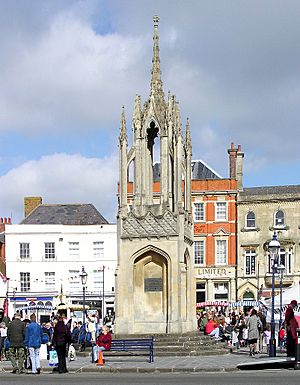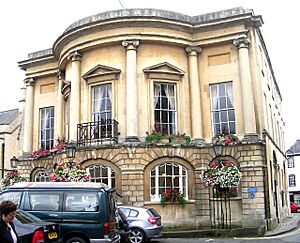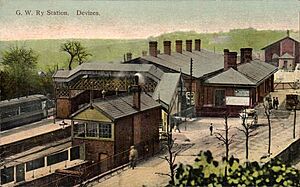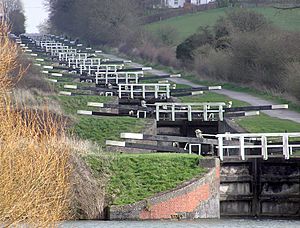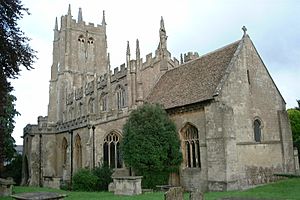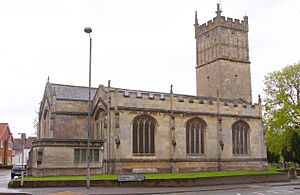Devizes facts for kids
Quick facts for kids Devizes |
|
|---|---|
| Market town and civil parish | |
 Market Place |
|
 Arms of Devizes |
|
| Population | 16,834 (2021 Census) |
| OS grid reference | SU0061 |
| Civil parish |
|
| Unitary authority |
|
| Ceremonial county | |
| Region | |
| Country | England |
| Sovereign state | United Kingdom |
| Post town | Devizes |
| Postcode district | SN10 |
| Dialling code | 01380 |
| Police | Wiltshire |
| Fire | Wiltshire |
| Ambulance | Great Western |
| EU Parliament | South West England |
| UK Parliament |
|
Devizes is a busy market town in Wiltshire, England. It grew up around Devizes Castle, a castle built in the 11th century. The town was given a special permission, called a charter, in 1141 to hold markets.
The castle was attacked during two important wars. First, during "the Anarchy" in the 12th century. Later, it was attacked during the English Civil War. The castle was destroyed in 1648, and not much of it remains today.
From the 1500s, Devizes was known for making textiles (cloth). By the early 1700s, it had the biggest corn market in the West Country. The Corn Exchange building was built in 1857 for this trade. Later, the town also became known for brewing (making beer) and making snuff. The Wadworth Brewery started here in 1875 and is still open.
Devizes is located on the western edge of the Vale of Pewsey. It is about 10.5 miles (17 km) southeast of Chippenham. It is also about 11 miles (18 km) northeast of Trowbridge, the county town. The town has almost 500 historic buildings. It also has several churches, a town hall, and a green space in the middle.
Contents
History of Devizes
Devizes Castle was built by Osmund, who was the Bishop of Salisbury, in 1080. However, the town itself is not mentioned in the famous Domesday Book of 1086.
The castle was built where the land of three different areas met. Because of this, it was called castrum ad divisas, which means "the castle at the boundaries." This is how the name Devizes came about. On an old map from 1611, the town was called The Devyses.
The first castle was a simple wooden and earth structure. It was a "motte and bailey" castle. This first castle burned down in 1113. A new castle was then built from stone by Roger of Salisbury.
Devizes got its first charter in 1141. This allowed the town to hold regular markets. The castle was fought over many times during "the Anarchy." This was a civil war in the 12th century between Stephen and Matilda. Important prisoners were held at the castle. One was Robert Curthose, the eldest son of William the Conqueror.
Devizes has had churches since the 12th century. Today, there are four Church of England churches.
During the 12th and 13th centuries, the town grew outside the castle walls. Craftsmen and traders set up shops to serve the castle residents. The first known market in Devizes was in 1228. This market was originally near St Mary's Church. The main goods sold were wheat, wool, and yarn. Later, cheese, bacon, and butter became important too.
In 1643, during the English Civil War, Parliamentary soldiers attacked Royalist forces in Devizes. The Royalists were led by Sir Ralph Hopton. The attack was stopped by a group of soldiers from Oxford. These soldiers were led by Henry Wilmot, 1st Earl of Rochester. The Parliamentary forces were almost completely defeated at the Battle of Roundway Down.
Devizes stayed under Royalist control until 1645. Then, Oliver Cromwell attacked and made the Royalists give up. The castle was destroyed in 1648 by order of Parliament. This process is called slighting. Very little of the original castle remains today. Most of what you see now was built in the 19th century.
From the 1500s, Devizes became famous for its textiles. At first, they made white woollen cloth. Later, they made other fabrics like serge and felt. By the mid-1700s, Devizes had the biggest corn market in the West Country. Before the Corn Exchange was built in 1857, wheat and barley were sold outdoors. Sacks were piled up around the market cross. The cross built in 1814 tells a story. It says a woman named Ruth Pierce dropped dead after being caught cheating.
Rich wool merchants built fancy houses in the town. These were in areas like St. John's and Long Street. They also built houses around the market place. By the end of the 1700s, textile making slowed down. But other jobs grew, like clock-making, bell making, and bookselling. In the 18th century, brewing, tobacco curing, and snuff making started. Brewing still happens at the Wadworth Brewery. However, the tobacco and snuff businesses are gone.
The pond called The Crammer, east of the town, is linked to the 18th-century Moonrakers story. This story gave people from Wiltshire a special nickname.
In 1794, a meeting at the Bear Hotel decided to create a group of soldiers called the yeomanry. This group later became the Royal Wiltshire Yeomanry. In 1810, the local militia (a group of citizens trained as soldiers) in Devizes rebelled. The Royal Wiltshire Yeomanry were called to stop them. The two groups faced each other with loaded guns in the Market Square. The militia leaders then gave up. The Royal Wiltshire Yeomanry served in wars at home and abroad. Today, parts of this group are still active in the Royal Wessex Yeomanry.
A new Devizes Prison opened in 1817. It replaced an older prison built in 1579. The new prison was made of brick and stone. It was designed by Richard Ingleman. It was shaped like a polygon around a central house for the governor. The prison was used for over 90 years. It closed in 1922 and was torn down by 1928. It stood near the Kennet and Avon Canal.
Devizes has more than 500 listed buildings. This is a lot for a town its size. A map called the Town Trail helps people find many of them. For example, 17 Market Place is a large, important house from the early 1700s. Brownston House on New Park Street is another important house. It was home to several Members of Parliament and Army Generals. It was also a boarding school for young ladies. Southbroom House, near the Green, was built in 1501. It burned down and was rebuilt in 1772. It is now part of Devizes School.
The town was a popular stop for mail coaches and stagecoaches. These coaches travelled between London and Bristol. You can still see many old coaching inns (hotels) in the town. The Kennet and Avon Canal opened fully by 1810. It passes very close to the town centre. Devizes also got a railway station in 1857. But the train line closed in 1966.

In 1853, the Wiltshire Archaeological and Natural History Society started in Devizes. They later opened a museum in Long Street. This is now the Wiltshire Museum. Its collections are very important to the country. The museum has many items from the Bronze Age. These include finds from the Stonehenge and Avebury World Heritage Site. There are plans to move the museum to the old Devizes Assize Court. This new location will also have space for community events.
There was a military base in the town called Le Marchant Barracks. It was there from 1878 until the 1980s.
In 1999, a hill figure of a white horse was carved into a hill near Roundway Hill. It is called the Devizes White Horse. It replaced an older one from 1845.
In 2014, the town celebrated the 200th anniversary of the Market Cross.
Geography
Devizes is about 90 miles (145 km) west-southwest of Central London. It is almost 2 degrees west of the Greenwich Meridian. The 2-degree line actually runs through the western edge of the town.
Towns near Devizes include Melksham, Pewsey, Calne, and Westbury.
Some areas that are part of Devizes include Hartmoor, Jump Farm, Northgate, Nursteed, Roundway, Southbroom, and Wick.
Governance
Devizes is a civil parish with an elected town council. As of 2024, the council has 11 members from the Devizes Guardians group, 7 Conservatives, 1 Labour, and 2 Independent members. The parish includes a small area called Dunkirk.
Much of the town's built-up area is in the nearby civil parish of Roundway. A smaller part is in Bishops Cannings parish. Both of these have their own parish councils. In 2017, Roundway and Devizes elected a joint parish council for the first time.
The town is part of the Wiltshire Council unitary authority. This means Wiltshire Council handles most major local services. The town and parish councils offer advice and local input. Before 1974, Devizes was a municipal borough with its main office at Devizes Town Hall.
Devizes has four electoral wards. The total population of these wards was over 17,700 in 2017.
Devizes is part of the Melksham and Devizes area for the UK Parliament. This area was created recently. In the 2024 election, it was won by Brian Mathew from the Liberal Democrats.
The town has special partnerships, called twinning associations, with other towns. These are Mayenne in France, Oamaru in New Zealand, Tornio in Finland, and Waiblingen in Germany.
Economy
Devizes has always been a market town. The market square is still used for a market every Thursday. There are also farmers' markets on the first Saturday of each month. Indoor traders set up every day in the historic Shambles.
The town centre has over 70 independent shops. Many are around the Market Place, Little Brittox, and Brittox. At the town's wharf on the canal, the Kennet and Avon Canal Trust has a small museum and cafe.
A new Devizes Health Centre is being built. It started in 2021. This two-storey building will replace services from the old Devizes Community Hospital. It will offer many different health services.
Culture
Devizes has a lively arts and culture scene. The Devizes International Street Festival brings thousands of people to the town. It lasts for two weeks before the August Bank Holiday. It starts with a "confetti battle" where people throw confetti at each other in the Market Place.
The yearly Devizes Arts Festival has many music events. It also features poets, authors, talks, and comedians. Each autumn, the Devizes Food and Drink Festival offers chances to eat in unusual places.
There is an active theatre group that performs at the Wharf Theatre. This theatre used to be a warehouse next to the canal.
Media
The local radio station is Fantasy Radio. It is a community radio station that broadcasts on 97 FM.
The Gazette and Herald is the town’s local weekly newspaper.
Transport
In 1857, the Great Western Railway built a train line to Devizes from Holt Junction. In 1862, this line was extended. It created a direct route between London Paddington and the West Country through Devizes. A small train stop called Pans Lane Halt opened in 1929.
However, a new train line built in 1900 took most of the train traffic away from Devizes. British Rail closed the Devizes line in 1966. The station was torn down soon after. Today, the closest train stations are in Melksham, Chippenham, and Pewsey. There is a plan to open a new station near Lydeway, southeast of the town.
Devizes has bus services to nearby towns. These include Swindon, Trowbridge, Salisbury, Bath, and Chippenham. All these towns have train services. Devizes also has a daily National Express bus service to London Victoria. This bus also stops at Heathrow Airport. There is a regular bus service to Stonehenge.
Devizes is about 15 miles (24 km) from the M4 motorway. Several main roads pass through the town. These include the A360, A361, and A342.
The Kennet and Avon Canal was built between 1794 and 1810. It connects Devizes with Bristol and London. Near Devizes, the canal rises 237 feet (72 m) using 29 locks. Sixteen of these locks are in a straight line at Caen Hill. In the past, the canal was lit by gas lights at night. This allowed boats to use the locks at any time.
The canal was not used much after railways arrived in the 1840s. But it was restored between 1970 and 2003 for fun activities. The Kennet and Avon Canal Trust runs a museum at The Wharf in Devizes. The town is also the starting point for the yearly Devizes to Westminster International Canoe Marathon.
National Cycle Route 4 follows the canal path through the town.
Education
Devizes School is a secondary school with a sixth form. It takes students from the town and nearby areas. It is located on the grounds of the Southbroom House estate. The historic house is now the school's main office.
Downland School is a special school for boys aged 11–16. Braeside is an outdoor education centre run by Wiltshire Council.
Devizes has six primary schools: St Joseph's Catholic Primary School, Southbroom St James Academy, Southbroom Infants' School, Wansdyke Community School, Nursteed Community Primary School, and The Trinity CofE (VA) Primary School. Rowde CofE Primary Academy is in the nearby village of Rowde.
Long Street used to have several private schools. Brownston House was home to Miss Bidwell's Ladies Boarding School from 1859 to 1901. A private Devizes Grammar School was also in Heathcote House.
The closest university is the University of Bath.
Religious sites
Devizes has four Church of England churches. It has also had other Christian groups since the 1600s.
Church of England
The two oldest churches, St. John's and St. Mary's, are from the 12th century. They are very important historic buildings. They share one rector (priest).
St. John's is close to Devizes Castle. It might have started as the castle's chapel. The oldest parts of the church are from 1130. This was soon after the castle was rebuilt. It has a large tower. Parts of the church were rebuilt in the 15th century.
St. Mary's was built in the 12th century for the townspeople outside the castle. Only the front part of the church is original. The rest was rebuilt in the 15th century. This includes its tall tower.
The church of St. James, Southbroom, is on the edge of the green. It is next to the pond called the Crammer. It was first mentioned in 1461. The tower is from the 15th century. The main part of the church was rebuilt in 1831–32. After the Le Marchant Barracks were built in 1878, St. James's became the church for the soldiers.
St. Peter's Church, west of the town centre, was built in 1865–66.
Other churches
The Catholic church of Our Lady of the Immaculate Conception opened in 1865. It was made bigger in 1909. St. Joseph's Catholic Primary School is next to this church.
Maryport Street Baptist Chapel was built in 1780. It has been made bigger several times and is still used today.
Salem Chapel was built in 1838. It is now used by Rock Community Church.
The New Baptist Church opened in 1852. It is now called Sheep Street Baptist Church.
St. Andrew's Church, Long Street, was built as a Methodist chapel in 1898. It is now a combined Methodist and United Reformed Church.
The Salvation Army used an old Methodist Chapel for many years. They later built a new hall on Station Road, which opened in 1971. The Salvation Army group in Devizes closed in the 2010s.
A chapel was built at Northgate Street in 1776. It was first for Calvinist Methodists and then for Congregationalists. The building is now used as homes.
Quakers have a meeting room at Sussex Wharf, by the canal.
Emergency services
Wiltshire Police are based in Devizes. Their main office is on London Road. Wiltshire Constabulary was the first county police force in the country. Its motto is 'Primus et Optimus – The First and The Best'. The police force is one of the biggest employers in Devizes.
The police headquarters also has the emergency control centre for the county. This centre was opened in 2003. The office of the Wiltshire Police and Crime Commissioner has been here since 2012. Wiltshire Air Ambulance was also based here until 2018.
Healthcare and ambulance services in Devizes are provided by the National Health Service. South Western Ambulance Service has an ambulance station in Devizes.
Fire and rescue services are provided by Dorset and Wiltshire Fire and Rescue Service. They have a fire station with staff who are on call. They also have a training centre.
Sport
Every year at Easter, the Devizes to Westminster International Canoe Marathon takes place. It is a 125-mile (201 km) race between Devizes and Westminster in London. The first race was in 1948.
The local association football (soccer) team is Devizes Town F.C.. They play in the Western League.
The local rugby union team is Devizes R.F.C. They were founded in 1876. They are known as the 'Saddlebacks'.
Devizes Cricket Club started in 1850. They play in the top league of the West of England Premier League. The ladies team started in 2013.
Devizes Hockey Club plays in the Premier 1 Hockey League.
Notable people
- Sir Harold Walter Bailey (1899–1996), a famous expert on old languages.
- James Bittner (born 1982), a professional football player.
- David Domoney (born 1963), a TV gardener who co-presents Love Your Garden.
- Fanny Duberly (1829–1902), a soldier's wife who travelled with her husband during wars.
- Paul Fletcher (born 1965), an Australian politician, born in Devizes.
- A. W. Lawrence (1900–1991), a historian and brother of T. E. Lawrence.
- Daphne Oram (1925–2003), a composer.
- Sir Thomas Lawrence (1769–1830), a famous artist.
- Simon May (born 1944), a songwriter.
- Richard of Devizes (late 12th century), an English writer of history.
- Clive Robertson (born 1965), an actor.
- Andy Scott (born 1949), lead guitarist for the band Sweet.
- William Heath Strange (1837–1907), a doctor who started a hospital.
- William Sylvester (1831–1920), a soldier who received the Victoria Cross for bravery.
Images for kids
See also
 In Spanish: Devizes para niños
In Spanish: Devizes para niños



